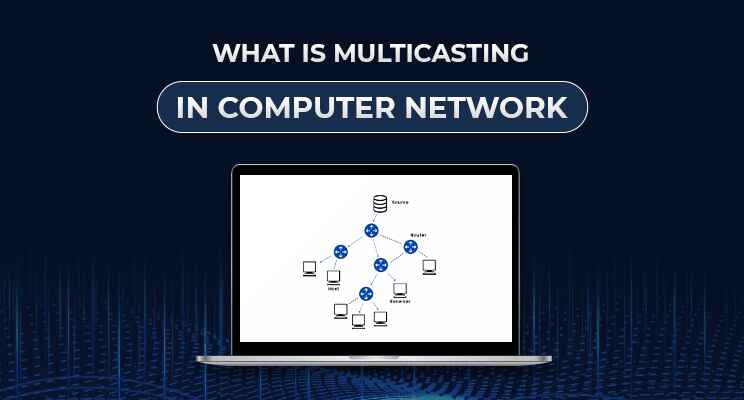With data-driven communication and real-time streaming of media, the name of the game is efficiency. Classical data transfer methods such as unicast and broadcast are useful in their own right, but for delivering the same information to multiple recipients at the same time, multicasting is the intelligent way to go. In this blog entry, we will discuss multicasting in computer networks, how it works, applications in the real world, and how it relates to related topics such as DHCP, cloud computing, and ethical hacking.
This is a must-read for UniNets students and IT professionals undertaking UniNets training courses, particularly in cloud computing training, networking, and ethical hacking training.
What Is Multicasting in Computer Networks?
Multicasting is a network communication technique by which data is sent from a single sender to various specific receivers belonging to a multicast group. In contrast to broadcasting (data is broadcast to all devices on a network), multicast in computer networks sends data to only those devices that require it, conserving bandwidth and enhancing efficiency.
Essentially, multicasting is a scalable and efficient form of one-to-many communication that is suited for applications such as IPTV, video conferencing, webcasts, and distribution of stock market data.
How Multicasting Works
Multicasting works by making use of reserved IP address ranges (224.0.0.0 and 239.255.255.255 for IPv4) specifically for use by multicasting traffic. Routers and switches within a multicasting network utilize protocols like IGMP (Internet Group Management Protocol) and PIM (Protocol Independent Multicast) to handle group memberships and delivery efficiency.
For instance, when a user subscribes to a live webinar, his/her device instructs the network to subscribe to a certain multicast group. The router will then make sure that the multicast stream will only be delivered to devices that belong to that group, minimizing redundant data transmission over the network.
Why Multicasting is Important
Multicasting is particularly significant in large networks where data must be delivered to several recipients with minimum redundancy. Below are the reasons why multicasting is important:
Bandwidth Efficiency: Multicast eliminates duplicate traffic and conserves bandwidth.
Real-Time Communication: Suitable for supporting delay-critical applications such as video streaming.
Scalability: Perfect for delivering data to hundreds or thousands of recipients.
Cost Efficiency: Saves infrastructure and data transfer expenses.
Real-World Applications of Multicasting
Video Streaming and IPTV: Broadcasters employ multicasting to send the same video stream to thousands of subscribers at once.
Stock Market Feeds: Financial institutions depend on multicast to send real-time updates.
Online Classrooms & Webinars: Multicast enables big virtual classes in educational sites without network congestion.
Software Distribution: IT administrators deploy updates to several machines simultaneously via multicast.
Relation to DHCP and the DORA Process
You may ask: how does DHCP fit with multicasting? Although DHCP and multicasting have disparate purposes, they coexist in enterprise settings.
DHCP refers to Dynamic Host Configuration Protocol, which is a process that configures IP addresses automatically on devices in a network. DHCP server's full form is Dynamic Host Configuration Protocol Server.
DHCP DORA Process
The DHCP DORA process—Discover, Offer, Request, Acknowledge—automates the process of assigning IP addresses. This enables new devices entering a multicast network to obtain their network settings without user intervention.
Without a DHCP server, you’d need to manually configure each device to join a multicast group.
With DHCP, the setup is automated, seamless, and efficient.
At UniNets, our networking courses explain this synergy between DHCP and multicasting, especially in large-scale enterprise deployments.
Multicasting in the Cloud
Modern cloud computing examples like live content delivery, container orchestration, and software updates heavily rely on multicasting principles, although often implemented with virtualized tools.
Cloud providers such as AWS, Azure, and Google Cloud encapsulate most of the networking, yet multicasting knowledge is still important for network architects.
Cloud computing students learn to develop scalable, distributed applications in which multicast-type efficiency is obtained through load balancing and group messaging services. These topics are particularly significant in cloud certification course preparation at UniNets.
Multicasting and Ethical Hacking
From a security standpoint, multicasting can be a vulnerability for attack, where data may be injected or sniffed. Receivers of multicast streams must be segmented and encrypted if they are to be safe.
Multicast protocols must be comprehended by ethical hackers to:
Inspect suspicious traffic in multicast groups
Identify spoofed multicast sources
Preserve streaming and real-time services from disruption
Therefore, ethical hacking training at UniNets covers modules on secure multicast implementations as well as how to detect multicast-related vulnerabilities.
Ethical Hacking Salary & Skills
Multicasting mastery can enhance your resume and even raise your ethical hacking salary because it reflects thorough knowledge of cutting-edge networking protocols—talents that are coveted by cybersecurity employers themselves.
If you're thinking about ethical hacking courses online, ensure multicasting, DHCP, and cloud security are included in the syllabus.
Multicasting vs. Other Modes of Transmission
In order to really understand how efficient multicast is on computer networks, you must compare it to other modes:
Unicast: One-to-one. Best suited for personal conversation but inefficient when communicating to a group.
Broadcast: One-to-all. Good for discovery protocols such as DHCP but wastes bandwidth.
Multicast: One-to-many. Sends data only to subscribed devices.
This is knowledge critical for students in UniNets' cloud computing courses because effective data communication is a fundamental principle of cloud infrastructure design.
Computer network multicasting is a very effective way of sending data to more than one recipient at a time. Multicast is an important technology in current networked systems, particularly for real-time applications such as streaming, conferencing, and data feeds. Knowledge of multicast is crucial not only for network engineers but also for cloud computing professionals, ethical hackers, and IT managers.
At UniNets, our courses—beginning from cloud certification courses to certified ethical hacking courses—empower students with real-world knowledge and hands-on skills in technologies such as multicast, DHCP, and cloud security.





Comments